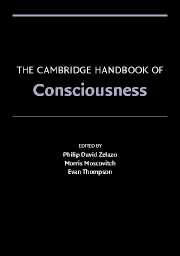Book contents
- The Cambridge Handbook of Consciousness
- The Cambridge Handbook of Consciousness
- Copyright page
- Dedication
- Contents
- List of Contributors
- The Cambridge Handbook of Consciousness
- Chapter 1 Consciousness: an introduction
- Part I The cognitive science of consciousness
- Part II The neuroscience of consciousness
- Chapter 25 Hunting the ghost: toward a neuroscience of consciousness
- Chapter 26 Neurodynamical approaches to consciousness
- Chapter 27 The thalamic intralaminar nuclei and the property of consciousness
- Chapter 28 The cognitive neuroscience of memory and consciousness
- Chapter 29 The affective neuroscience of consciousness: higher-order syntactic thoughts, dual routes to emotion and action, and consciousness
- Chapter 30 Consciousness: situated and social
- Part III Quantum approaches to consciousness
- Author Index
- Subject Index
Chapter 28 - The cognitive neuroscience of memory and consciousness
from Part II - The neuroscience of consciousness
Published online by Cambridge University Press: 05 June 2012
- The Cambridge Handbook of Consciousness
- The Cambridge Handbook of Consciousness
- Copyright page
- Dedication
- Contents
- List of Contributors
- The Cambridge Handbook of Consciousness
- Chapter 1 Consciousness: an introduction
- Part I The cognitive science of consciousness
- Part II The neuroscience of consciousness
- Chapter 25 Hunting the ghost: toward a neuroscience of consciousness
- Chapter 26 Neurodynamical approaches to consciousness
- Chapter 27 The thalamic intralaminar nuclei and the property of consciousness
- Chapter 28 The cognitive neuroscience of memory and consciousness
- Chapter 29 The affective neuroscience of consciousness: higher-order syntactic thoughts, dual routes to emotion and action, and consciousness
- Chapter 30 Consciousness: situated and social
- Part III Quantum approaches to consciousness
- Author Index
- Subject Index
Summary
Keywords
- Type
- Chapter
- Information
- Publisher: Cambridge University PressPrint publication year: 2007
- 1
- Cited by

